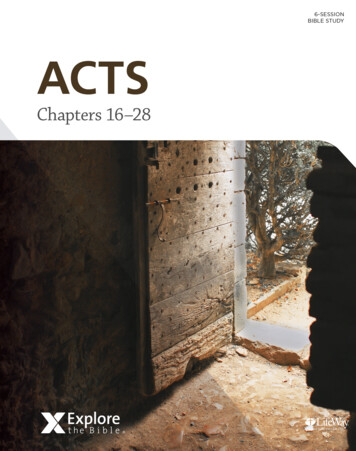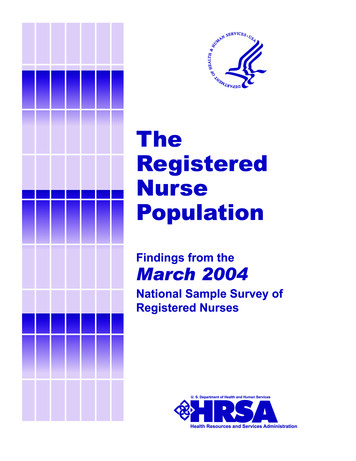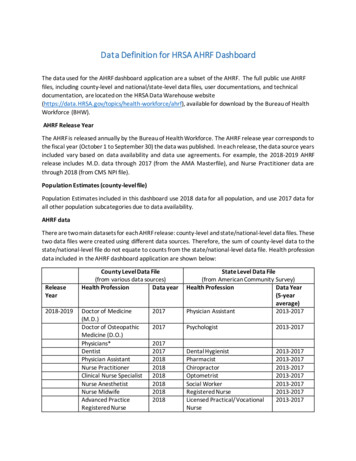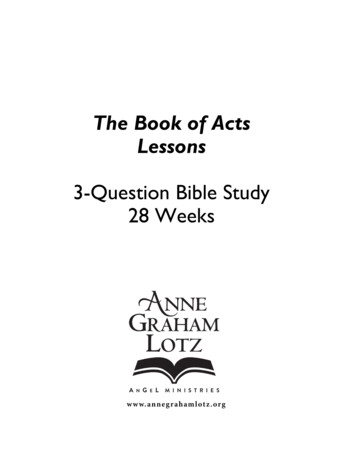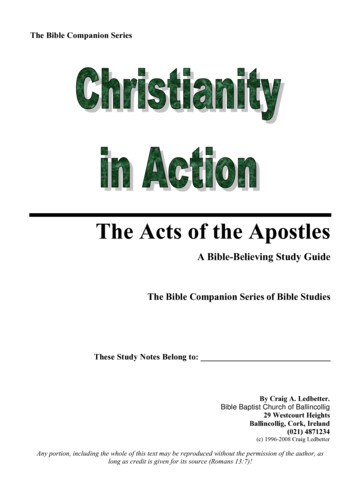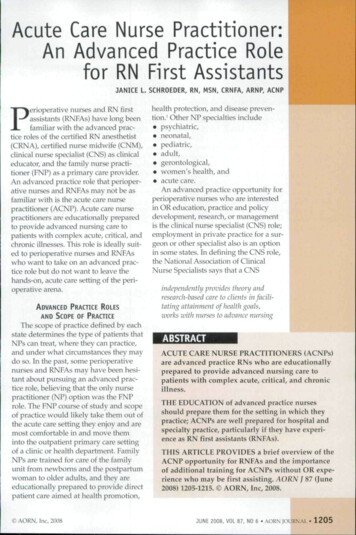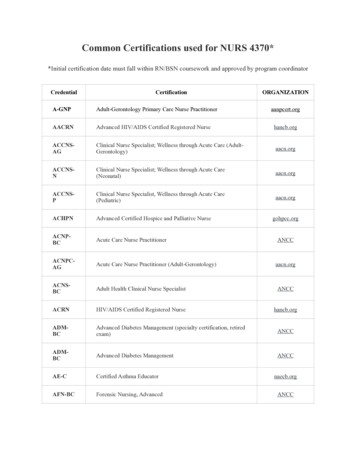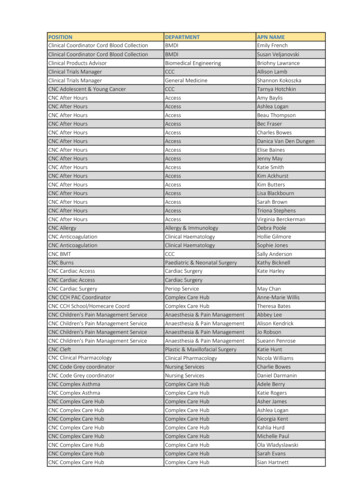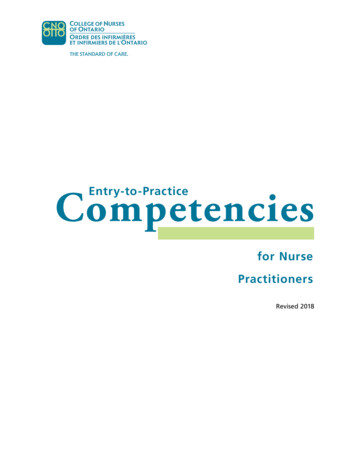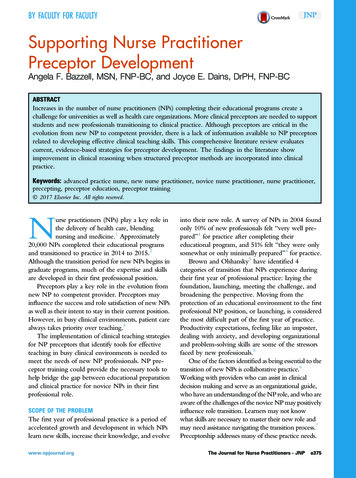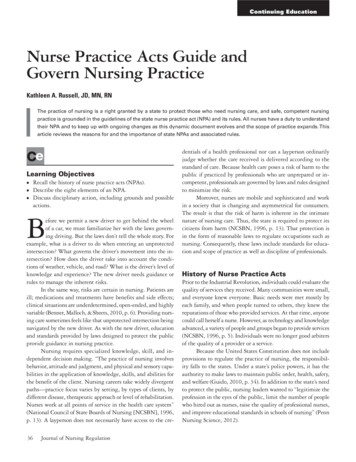
Transcription
Continuing EducationNurse Practice Acts Guide andGovern Nursing PracticeKathleen A. Russell, JD, MN, RNThe practice of nursing is a right granted by a state to protect those who need nursing care, and safe, competent nursingpractice is grounded in the guidelines of the state nurse practice act (NPA) and its rules. All nurses have a duty to understandtheir NPA and to keep up with ongoing changes as this dynamic document evolves and the scope of practice expands. Thisarticle reviews the reasons for and the importance of state NPAs and associated rules.CeLearning Objectives Recall the history of nurse practice acts (NPAs).Describe the eight elements of an NPA.Discuss disciplinary action, including grounds and possibleactions.Before we permit a new driver to get behind the wheelof a car, we must familiarize her with the laws governing driving. But the laws don’t tell the whole story. Forexample, what is a driver to do when entering an unprotectedintersection? What governs the driver’s movement into the intersection? How does the driver take into account the conditions of weather, vehicle, and road? What is the driver’s level ofknowledge and experience? The new driver needs guidance orrules to manage the inherent risks.In the same way, risks are certain in nursing. Patients areill; medications and treatments have benefits and side effects;clinical situations are underdetermined, open-ended, and highlyvariable (Benner, Malloch, & Sheets, 2010, p. 6). Providing nursing care sometimes feels like that unprotected intersection beingnavigated by the new driver. As with the new driver, educationand standards provided by laws designed to protect the publicprovide guidance in nursing practice.Nursing requires specialized knowledge, skill, and independent decision making. “The practice of nursing involvesbehavior, attitude and judgment, and physical and sensory capabilities in the application of knowledge, skills, and abilities forthe benefit of the client. Nursing careers take widely divergentpaths—practice focus varies by setting, by types of clients, bydifferent disease, therapeutic approach or level of rehabilitation.Nurses work at all points of service in the health care system”(National Council of State Boards of Nursing [NCSBN], 1996,p. 13). A layperson does not necessarily have access to the cre36Journal of Nursing Regulationdentials of a health professional nor can a layperson ordinarilyjudge whether the care received is delivered according to thestandard of care. Because health care poses a risk of harm to thepublic if practiced by professionals who are unprepared or incompetent, professionals are governed by laws and rules designedto minimize the risk.Moreover, nurses are mobile and sophisticated and workin a society that is changing and asymmetrical for consumers.The result is that the risk of harm is inherent in the intimatenature of nursing care. Thus, the state is required to protect itscitizens from harm (NCSBN, 1996, p. 13). That protection isin the form of reasonable laws to regulate occupations such asnursing. Consequently, these laws include standards for education and scope of practice as well as discipline of professionals.History of Nurse Practice ActsPrior to the Industrial Revolution, individuals could evaluate thequality of services they received. Many communities were small,and everyone knew everyone. Basic needs were met mostly byeach family, and when people turned to others, they knew thereputations of those who provided services. At that time, anyonecould call herself a nurse. However, as technology and knowledgeadvanced, a variety of people and groups began to provide services(NCSBN, 1996, p. 5). Individuals were no longer good arbitersof the quality of a provider or a service.Because the United States Constitution does not includeprovisions to regulate the practice of nursing, the responsibility falls to the states. Under a state’s police powers, it has theauthority to make laws to maintain public order, health, safety,and welfare (Guido, 2010, p. 34). In addition to the state’s needto protect the public, nursing leaders wanted to “legitimize theprofession in the eyes of the public, limit the number of peoplewho hired out as nurses, raise the quality of professional nurses,and improve educational standards in schools of nursing” (PennNursing Science, 2012).
The first nurse registration law, enacted in 1903 in NorthCarolina, was written to do just that—protect the title of nurseand improve the practice of nursing. Developing nursing exams and issuing licenses was entrusted to the North CarolinaBoard of Nursing (UNC TV, 2012). New Jersey, New York, andVirginia passed registration laws that same year. These early actsdid not define the practice of nursing, but in 1938, the state ofNew York did define a scope of practice for nursing (NCSBN,2010). By the 1970s, all states required licensure for registeredand practical nurses.Advanced practice nurses can be traced to the Civil War,when nurses assisted during surgery with anesthesia services(Hamric, Spross, & Hanson, 2005, p. 4). Advanced practice registered nurse (APRN) roles and specialization have continued tothis day as has the evolution of formal scope of practice languagewithin legislative statutes.Nurse’s Guide to ActionHow could a law function as a guide to action if almost no oneknows it? (Howard, 2011, p. 30). The laws of the nursing profession can only function properly if nurses know the current lawsgoverning practice in their state.All states and territories have enacted a nurse practice act(NPA). Each state’s NPA is passed by the state’s legislature. Butthe NPA itself is insufficient to provide the necessary guidancefor the nursing profession. Therefore, each NPA establishes aboard of nursing (BON) that has the authority to develop administrative rules or regulations to clarify or make the law morespecific. Rules and regulations must be consistent with the NPAand cannot go beyond it. These rules and regulations undergoa process of public review before enactment (NCSBN, 2011a;Ridenour & Santa Anna, 2012, p. 504). Once enacted, rules andregulations have the full force and effect of law.Although the specificity of NPAs varies among states, allNPAs include: definitions authority, power, and composition of a BON educational program standards standards and scope of nursing practice types of titles and licenses protection of titles requirements for licensure grounds for disciplinary action, other violations, and possibleremedies.DefinitionsFor the intent of a law to be useful to legislators and citizens,terms or phrases used in statutes must be clear and unambiguous. Of course, a law does not need to define terms that arecommonly understood. However, definitions are often includedin laws to avoid uncertainty about the meaning of words. ForVolume 3/Issue 3 October 2012example, encumbered, reinstatement, and reactivation are often defined in NPAs. An encumbered license is defined as a license withcurrent discipline, conditions, or restrictions. Reinstatement isdifferent from reactivation in that the former refers to reissuanceof a license following disciplinary action, whereas the latter is areissuance not related to disciplinary action (NCSBN, 2012a).Authority, Power, and Composition of a BONThe NPA gives authority to regulate the practice of nursing andthe enforcement of law to an administrative agency or BON thatis charged with maintaining the balance between the rights ofthe nurse to practice nursing and the responsibility to protect thepublic health, safety, and welfare of its citizens (Brous, 2012, p.508). The membership and qualifications of the BON, usuallycomposed of registered nurses (RNs), licensed practical/vocational nurses (LPN/VNs), advanced practice nurses, and members representing the public, are specified by the NPA. Specificsregarding terms of office, meetings, and election of officers arealso included.How the membership of the BON is constituted dependson state statute. Some states give the governor authority to appoint members to the BON after reviewing suggestions fromprofessional nursing organizations. Other states require nominations from professional organizations with appointment by thedirector or head of the regulatory agency. In North Carolina,members of the BON are elected by the general public. In stillother states, the legislature appoints public members (Brent,2012, p. 2). The BON typically hires an executive officer, whohas the authority to staff the office with nurses, attorneys, investigators, and administrative staff.Typically, the powers and duties of BONs include: hiring BON employees making, adopting, amending, repealing, and enforcing rules setting nursing education standards setting fees for licensure performing criminal background checks licensing qualified applicants maintaining database of licensees ensuring continuing competence developing nursing standards of practice collecting and analyzing data implementing discipline process regulating unlicensed assistive personnel.Educational Program StandardsThe BON must set standards for prelicensure nursing educational programs and clinical learning experiences and approve suchprograms that meet requirements of the NPA. These standardsare reflected in the rules that accompany the NPA. The standardsfor prelicensure programs include accreditation, curriculum specifics, administrator and faculty qualifications, continuing ap-www.journalofnursingregulation.com37
proval, and approval of new, or withdrawal of approved, nursingeducation programs.Specific curriculum rules often include necessary standardsof evidence-based clinical judgment; skill in clinical management; biologic, physical, social, and behavioral science requirements; professional responsibilities; legal and ethical issues;patient safety; and best practices of nursing.Standards and Scope of Nursing PracticeOne’s nursing care is both directed and measured by the NPAand rules. The standards and scope of nursing practice within anNPA are aligned with the nursing process. For example, comprehensive nursing assessment based on biologic, psychological, andsocial aspects of the patient’s condition; collaboration with thehealth care team; patient-centered health care plans, includinggoals and nursing interventions, can all be language within theNPA. Further standards include decision making and criticalthinking in the execution of independent nursing strategies,provision of care as ordered or prescribed by authorized healthcare providers, evaluation of interventions, development of teaching plans, delegation of nursing intervention, and advocacy forthe patient.Rules are often more specific than the act. The NPA mayrequire safe practice, whereas the rules may specify a plan for safepractice, requiring orientation and training for competence whenencountering new equipment and technology or unfamiliar caresituations; communication and consultation with other healthteam members regarding patient concerns and special needs,status, or changes; response or lack of response to interventions;and significant changes in patient condition (NCSBN, 2012a,2012b).The NPA typically identifies delegating and assigning nursinginterventions to implement the plan of care as within an RN’s scope ofpractice (NCSBN, 2012a). The rules, however, spell out the RN’sresponsibility to organize, manage, and supervise the practiceof nursing. Indeed, the rules can delineate the specific steps foreffective delegation by an RN as ensuring: unlicensed assistive personnel (UAP) have the education, legal authority, and demonstrated competency to perform thedelegated task task is consistent with UAP’s job description task can be safely performed according to clear, exact, andunchanging directions results of the task are reasonably predictable task does not require assessment, interpretation, or independent decision making patient and circumstance are such that delegation of the taskposes minimal risk to the patient consequences of performing the task improperly are not lifethreatening38Journal of Nursing Regulation RN provides clear directions and guidelines regarding thetask (NCSBN, 2012b).Title and LicensureThe use of the title nurse by unlicensed individuals misleads andendangers the public. “This poses a serious threat to patient careand safety. Reserving the title nurse for only those meeting thelegal and educational standards allows the public to consult withprofessionals required to adhere to professional codes of practiceand ethics” (Pennsylvania State Nurses Association, 2011).NPA language generally includes a statement regardingthe title of RN and LPN/VN. By specifying that the title ofRN is “given to an individual intended to practice nursing” andLPN/VN is “given to an individual licensed to practice practical/vocational nursing,” the NPA protects these titles from beingused by unauthorized persons and therefore protects the public(NCSBN, 2012a).Each state’s NPA also includes statements regarding examination for licensure as RNs and LPN/VNs, including frequency and requisite education before examination and reexamination. Additional requirements of licensure by examinationtypically include: application and fee graduation from an approved prelicensure program or a program that meets criteria comparable to those established bythe state passage of the professional examination attestation of no report of substance abuse in the last 5 years verification of no report of actions taken or initiated againsta professional license, registration, or certification attestation of no report of acts or omissions that are groundsfor disciplinary action as specified in the NPA.The majority of jurisdictions include criminal backgroundchecks as an additional requirement for licensure (NCSBN,2012c).Further requirements are included in NPAs for licensureby examination of internationally educated applicants, licensureby endorsement, as well as licensure renewals, reactivation, andcontinuing education. Endorsement is an approval process fora nurse who is licensed in another state. Obtaining licensureby endorsement often includes prelicensure requirements andverification of licensure status from the state where the nurseobtained licensure by examination (NCSBN, 2012a).Although statutory language varies from state to state regarding the licensure of APRNs, most states recognize clinicalnurse specialist, nurse midwife, nurse practitioner, and registerednurse anesthetist as APRN roles and require certification by anational nurse certification organization. Education and specificscope of practice vary from state to state.
Grounds for Disciplinary Action, Other Violations, andPossible RemediesThe majority of nurses are competent and caring individuals whoprovide a satisfactory level of care. However, when a problemis experienced with a nurse and the nurse’s performance is notacceptable, a complaint may be filed with the BON. The BON,through its statutory authority specified in the NPA, is responsible for review and action regarding complaints. A BON cantake formal action only if it finds sufficient basis that the nurseviolated state laws or regulations. Each case varies and needs tobe considered on its own merits (Brous, 2012, pp. 510–511;NCSBN, 2012d). For an overview of the disciplinary processfrom receipt of complaint to resolution, see Figure 1.Disciplinary cases are often grouped into the followingcategories: Practice-related: breakdowns or errors during aspects of thenursing process Drug-related: mishandling, misappropriation, or misuse ofcontrolled substances Boundary violations: nontherapeutic relationships formed between a nurse and a client in which the nurse derives a benefitat the client’s expense (NCSBN, 2009) Sexual misconduct: inappropriate physical or sexual contactwith a client Abuse: maltreatment of clients that is physically, mentally, oremotionally harmful Fraud: misrepresentation of the truth for gain or profit (usuallyrelated to credentials, time, or payment) Positive criminal background checks: detection of reportable criminal conduct as defined by statute (NCSBN, 2011b, 2012e).If a substance use disorder is suspected from the evidenceand there is no diversion of medication, BONs may offer thenurse a nondisciplinary alternative-to-discipline program. Theseprograms are not treatment programs—they are monitoringprograms. The possibility of avoiding the public notoriety ofdiscipline can be an important factor in breaking through thenurse’s denial of substance use disorder and movement to a program that will assist the nurse in retaining her or his license.These programs are designed to refer nurses for evaluation andtreatment, monitor the nurse’s compliance with treatment andrecovery recommendations, monitor abstinence from drug oralcohol use, and monitor their practice upon return to work.Alternative programs work to return nurses to practice whileprotecting the public. Various models of alternative programsexist, and their use varies among BONs. Some programs provideservices via the BON, a contracting agency, a special committeeof the BON, or a peer-assistance program of a professional association or a peer-assistance employee program (NCSBN, 2012f).For all other grounds, the final decision reached by theBON is based on the findings of an investigation and the resultsof the complaint process. The language used to describe the typesof actions available to BONs varies according to state statute.Volume 3/Issue 3 October 2012Figure 1Board of Nursing Complaint ProcessFiling a complaintInitial review of complaintInvestigationBoard proceedingsBoard actionsReporting and enforcementAlthough terminology may differ, board action affects the nurse’slicensure status and ability to practice nursing in the state takingaction. BON actions may include the following: Fine or civil penalty Referral to an alternative-to-discipline program for practicemonitoring and recovery support for those with drug- oralcohol-dependence or some other mental or physical condition Public reprimand or censure for minor violation of the NPA,often with no restrictions on license Imposition of requirements for monitoring, remediation, education, or other provision tailored to the particular situation Limitation or restriction of one or more aspects of practice,such as probation with limits on role, setting, activities, orhours worked Separation from practice for a period of time (suspension) orloss of license (revocation or voluntary surrender) Other state-specific remedies (NCSBN, 2012g).BON actions are considered public information, andmany BONs have determined that it is in the public interest topublicize their actions against nurses’ licenses and actions thatreinstate licenses. BONs use a variety of methods to communicate this information, including newsletters and websites. Also,federal law requires that adverse actions taken against a healthcare professional’s license be reported to federal databanks. TheNational Practitioner Data Bank and Healthcare Integrity andProtection Data Bank are two federal databanks created to serveas repositories of information about health care providers in theUnited States (NCSBN, 2012h).Being Informed About Your NPAIgnorance of the law is never an excuse! The NPA is not something one can study in a prelicensure nursing education programand then put aside. The act is a dynamic document that evolveswww.journalofnursingregulation.com39
and is updated or amended as changes in scope of practice occur.“Inherent in our current healthcare system are changes whichrelate to demographic changes (such as the aging of the “babyboomers”); advances in technology; decreasing healthcare dollars;advances in evidence-based healthcare procedures, practices andtechniques; and many other societal and environmental factors”(NCSBN, 2012i).Your state BON is a resource for the NPA. Links to NPAsare available on most state BON websites. Some BONs attemptto provide new information to nurses via their website or newsletter (Tedford, 2011). For example, the Virginia BON posts a listof frequently asked questions to help nurses navigate the variousaspects of licensure and posts announcements regarding practiceor licensing changes on their homepage (Satterlund, 2012).The practice of nursing is a right granted by a state toprotect those who need nursing care. The guidelines of the NPAand its rules provide safe parameters within which to work andprotect patients from unprofessional and unsafe nursing practice(Brent, 2012, p. 5). More than 100 years ago, state governmentsestablished BONs to protect the public’s health and welfare byoverseeing and ensuring the safe practice of nursing. Today,BONs continue their duty, but the law cannot function as aguide to action if almost no one knows about it. “To maintainone’s license in good standing and continue practicing, nursesmust understand that rights are always accompanied by responsibilities” (Brous, 2012, p. 506). Make sure you know your state’sNPA and rules before you enter into that unprotected intersection of nursing care.ReferencesBenner, P. E., Malloch, K., & Sheets, V. (Eds.). (2010). Nursing pathwaysfor patient safety. Chicago, IL: National Council of State Boards ofNursing.Brent, N. J. (2012). Protect yourself: Know your nurse practice act[Online CE]. Retrieved from ur-nurse-practice-actBrous, E. (2012). Nursing licensure and regulation. In D. J. Mason, J.K. Leavitt, & M. W. Chaffee (Eds.). Policy & politics in nursing andhealth care (6th ed.). St. Louis, MO: Saunders.Guido, G. W. (2010). Legal & ethical issues in nursing (5th ed.). Boston,MA: Pearson.Hamric, A. B, Spross, J. A., & Hanson, C. M. (2005). Advanced practicenursing: An integrative approach. St. Louis, MO: Elsevier Saunders.Howard, P. K. (2011). The death of common sense: How law is suffocatingAmerica. New York, NY: Random House.National Council of State Boards of Nursing. (1996). Why regulationpaper: Public protection or professional self-preservation. Chicago,IL: Author. Retrieved from www.ncsbn.org/pdfs/why regulationpaper.pdfNational Council of State Boards of Nursing. (2009). Professional boundaries: A nurse’s guide to the importance of appropriate professional boundaries [Brochure]. Chicago, IL: Author.National Council of State Boards of Nursing. (2010). Nurse practiceact—Arkansas v4 [Online course]. Retrieved from ournal of Nursing RegulationNational Council of State Boards of Nursing. (2011a). What you need toknow about nursing licensure and boards of nursing [Brochure] Chicago, IL: Author.National Council of State Boards of Nursing. (2011b). State and territorial boards of nursing: What every nurse needs to know [Brochure]. Chicago, IL: Author.National Council of State Boards of Nursing. (2012a). Model Act. Chicago, IL: Author.National Council of State Boards of Nursing. (2012b). Model Rules.Chicago, IL: Author.National Council of State Boards of Nursing. (2012c). Criminal background checks. Retrieved from www.ncsbn.org/2946.htm?the url &rdePwdDays 9223372036854775807National Council of State Boards of Nursing. (2012d). Filing a complaint. Retrieved from www.ncsbn.org/163.htmNational Council of State Boards of Nursing. (2012e). Initial review ofa complaint. Retrieved from www.ncsbn.org/3772.htmNational Council of State Boards of Nursing. (2012f). Board proceedings. Retrieved from www.ncsbn.org/3774.htmNational Council of State Boards of Nursing. (2012g). Board action.Retrieved from www.ncsbn.org/3775.htmNational Council of State Boards of Nursing. (2012h). Reporting andenforcement. Retrieved from www.ncsbn.org/3776.htmNational Council of State Boards of Nursing. (2012i). Changes in healthcare professions’ scope of practice: Legislative considerations [Brochure].Retrieved from www.ncsbn.org/Scope of Practice 2012.pdfPenn Nursing Science. (2012). History of Nursing Timeline. Retrievedfrom www.nursing.upenn.edu/nhhc/Pages/timeline 1900-1929.aspx?slider1 1#chromePennsylvania State Nurses Association. (2011). Title protection. Retrieved from ur, N., & Santa Anna, Y. (2012) An overview of legislation andregulation. In D. J. Mason, J. K. Leavitt, & M. W. Chaffee (Eds.).Policy & politics in nursing and health care (6th ed.). St. Louis, MO:Saunders.Satterlund, M. (2012). Staying up-to-date on changing requirements.Virginia Nurses Today. Retrieved from 2 12.pdfTedford, S. A. (2011, October). When was the last time you read thenurse practice act? ASHN Update. Retrieved from x.php?i 83957&m &l &p 4&pre &ver swfUNC TV. (2012). North Carolina Nurses: A century of caring. Retrieved from www.unctv.org/ncnursing/thenandnow.htmlKathleen A. Russell, JD, MN, RN, is Associate, NursingRegulation, National Council of State Boards of Nursing,Chicago, Illinois.
PosttestNurse Practice Acts Guideand Govern Nursing PracticeLearning ObjectivesRecall the history of nurse practiceacts (NPAs). Describe the eight elements of anNPA. Discuss disciplinary action, including grounds and possible actions.The authors and planners of this CEactivity have disclosed no financialrelationships with any commercialcompanies pertaining to this activity. CeCE PosttestNurse Practice Acts Guide andGovern Nursing PracticeIf you reside in the United States andwish to obtain 1.4 contact hours ofcontinuing education (CE) credit,please review these instructions.InstructionsGo online to take the posttest andearn CE credit:Members – www.ncsbninteractive.org (no charge)Nonmembers – www.learningext.com ( 15 processing fee)If you cannot take the posttestonline, complete the print form andmail it to the address (nonmembersmust include a check for 15,payable to NCSBN) included atbottom of form.Provider accreditationThe NCSBN is accredited as aprovider of CE by the Alabama StateBoard of Nursing.The information in this CE does notimply endorsement of any product,service, or company referred to in thisactivity.Contact hours: 1.4Posttest passing score is 75%.Expiration: October 2015Volume 3/Issue 3 October 2012Please circle the correct answer.1. Which state was the first to enact anurse practice act (NPA)?a. North Carolinab. New Yorkc. New Jerseyd. Virginia2.a.b.c.d.What is the purpose of an NPA?To protect nurses from lawsuitsTo protect the publicTo guide federal health care policyTo guide workplace policy3. Which statement about the regulation ofnursing practice is correct?a. Every state and territory has adopted thesame set of rules and regulations fornursing practice.b. Each state has the authority to enact alaw governing nursing practice.c. The U.S. Constitution includes provisionsfor regulating the practice of nursing.d. Professional standards of practice areenacted through regulatory organizations.4. What is the best resource for informationabout an NPA?a. Healthcare Integrity and Protection DataBankb. U.S. Department of Health and HumanServicesc. State board of nursing (BON)d. American Nurses Association5.a.b.c.BON members are:elected officials who serve for 2 years.appointed by the governor.nurses and sometimes members of thepublic.d. hired by the BON’s executive officer.6. Some newly licensed RNs arediscussing their NPA during orientation.Which statement is incorrect and needsto be corrected by their preceptor?a. The NPA requires certification and amaster’s degree for all APRNs.b. The standards and scope of practice fornurses are aligned with the nursingprocess.c. The use of the title registered nurse isprotected by the NPA.d. The NPA sets standards for prelicensurenursing education.7. What is the relationship between anNPA and rules or regulations?a. A BON can enact a rule without inputfrom the public.b. A BON can change a regulation anytime.c. Rules can supersede the requirements ofan NPA.d. Rules are often more specific than theNPA.8. Which of the following is an example ofunacceptable delegation?a. The RN asks the unlicensed assistiveperson to help a client walk to thebathroom.b. The RN asks the unlicensed assistiveperson to measure and then record aclient’s vital signs.c. The RN assigns the LPN to care for aclient who is ready for discharge.d. The RN delegates medicationadministration to the LPN.9. Which of the following is a requirementfor initial licensure as a nurse in everystate?a. Confirmation of being drug free for atleast 1 yearb. Passing a licensure examinationc. Criminal background check verifying noarrest recordd. Endorsement by the state of permanentresidence10. A complaint is filed against a nurse.What can the nurse expect to happennext?a. The complaint will be investigated.b. The nurse’s license will be temporarilysuspended.c. The nurse will have a mandatoryreduction in work hours.d. The nurse will be monitored on the job.www.journalofnursingregulation.com41
11. After agreeing to participate in analternative-to-discipline program, anurse can expect:a. an announcement of her or hisparticipation in the program in anewsletter.b. an official letter of censure in her or hisworkplace records.c. to return to work with no restrictions.d. regular monitoring to ensure compliancewith treatment.12. Which type of discipline case involvesaccepting gifts and money from a clientwhile caring for him or her?a. Abuseb. Fraudc. Boundary violationd. Practice-related13. The nurse is renting a house from aformer client and, after several months,refuses to pay rent. The former clientfiles a complaint. This is an example ofwhich type of discipline case?a. Fraudb. Abusec. Boundary violationd. Practice-related14. A nurse leaves the long-term carefacility building for several hours withouttelling anyone and without authorization.It is later discovered
Educational Program Standards The BON must set standards for prelicensure nursing education-al programs and clinical learning experiences and approve such programs that meet requirements of the NPA. These standards are reflected in the rules that accompany the NPA. The standards for prelicensure programs include accreditation, curriculum spe-
